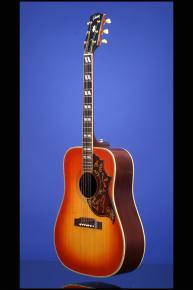Gram Parsons '61 Hummingbird…
This 15 3/4-inch-wide Square Shoulder Dreadnought weighs just 4.60 lbs. and has a wide nut width of just over 1 11/16 inches and a scale length of 25 1/2 inches. Mahogany back and sides, fine-grain spruce top, one-piece mahogany neck with a nice medium profile, and single-bound rosewood fretboard with 20 jumbo frets and inlaid pearl split-parallelogram position markers. Black headstock with inlaid pearl "Gibson" logo and pearl crown inlay. Two-layer black on white plastic bell-shaped truss-rod cover. Individual gold-plated single-line Kluson Deluxe tuners with single-ring Keystone plastic buttons. Brown celluloid pickguard with hummingbird, butterfly, and flowers etched in white and yellow. Rosewood tailpiece with two pearl dots and adjustable rosewood bridge.
The top has seven-ply binding, the back has five-ply binding, and the soundhole rings are in three groups of three, seven and three. Inside the soundhole is the orange label with Style "Guitar" / Gibson "Humming Bird" / Number "40620" stamped in black. The serial number "40620" is also stamped in blind on the back of the headstock. The "A" tuner button has shrunk a little but is stable and the "E" tuner has been changed for a matching, but slightly later (ca. 1964) Kluson double-line deluxe version. Housed in the original Gibson black hardshell case with orange plush lining (9.25).
"The Hummingbird is numbered among those elite guitars that look like no others, that are unmistakably individual and unique. Of all the models in the history of Gibson acoustic flat-tops, probably the venerable J-200 alone is more immediately identifiable than this peerless 'bird of paradise…Gibson introduced the Hummingbird, their first square-shoulder guitar, in 1960. Their goal: an instrument designed for vocal accompaniment, one whose warm and honeyed tone would complement the voice, not overpower it. In reaching this goal Gibson employed a radical design that resulted in an instrument more boxy than its round-shoulder predecessors…The price and quality of this new model were appropriate for a guitar second only to that of the J-200 among Gibson flat-tops…The new model was not only more visually stunning than the competition of the time (especially that of other guitar companies), it offered superior playing capabilities. The Hummingbird certainly gave the public what it wanted: sales jumped to 595 in 1961 from 156 the previous year. In fact, the model was selling so well that Gibson expanded the Hummingbird concept, creating the Dove, which was based on the same body as the Hummingbird, but had maple back and sides, a long-scale neck, and different external components. The Dove cost approximately 35 percent more than the Hummingbird and filled the price slot between it and the top-of-the-line J-200…By 1965 the Hummingbird had been relegated to number five in the Gibson lineup, according to price, behind the J-200, Dove, Heritage, and Everly Brothers guitars. Also in this year many changes were made in the Hummingbird. One of the more unusual involved triangles or rectangles of black paint on the guitar's sides, next to the neck heel…That year also saw a neck change, in which the peghead angle was reduced to 14 degrees from 17 and the neck was made more narrow, two modifications that affected the entire flat-top line at that time. Also, chrome plate supplanted nickel that year…During 1967 and 1968, in a short-lived experiment, pickguards were attached by tiny screws rather than glued; also, some nickel-plated tuners were found on the 'birds. In 1968 the top-belly bridge was replaced by a squarish bottom-belly design; the adjustable saddle was retained. At this time some Hummingbird tops were also finished with the traditional dark brown sunburst instead of the trademark cherryburst. The last year for the ultra-light Hummingbird construction that produced such excellent sound was 1968. Near the end of that year Gibson initiated major changes intended to increase production while keeping warranty work to aminimum. Thus, the braces on both top and back became large and bulky, as did the solid-wood bridge pad" (Eldon Whitford, David Vinopal, & Dan Erlewine, Gibson's Fabulous Flat-Top Guitars, pp. 111-114).
"Keith Richards has used Hummingbirds quite frequently throughout his career, alongside other acoustic guitars. His Hummingbird can be heard in many Rolling Stones songs, such as 'Let it Bleed', 'Love in Vain', 'No Expectations', and 'Dead Flowers'. Other notable Hummingbird players include Jimmy Page, Brian Jones, Marc Bolan, Sheryl Crow, The Edge, Bono, Sarah Harmer, Mick Jagger, Alan Sparhawk, John McLaughlin, Gram Parsons, Ryan Adams, KT Tunstall, Lefty Frizzell, Stoll Vaughan, and currently Michelle Branch is using one" (http://en.wikipedia.org/wiki/Gibson_Hummingbird).
Translate:










